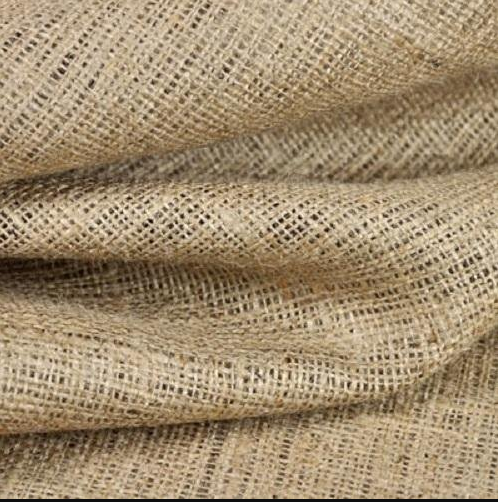Hessian fabrics, sometimes called rolled burlap, are versatile and timeless materials cherished for their rustic charm and unmatched durability. These fabrics have found their way into countless industries and are a staple in a wide array of engaging DIY projects. In this post, we will deeply dive into the intriguing world of Hessian fabrics, unraveling their manufacturing secrets and uncovering their distinctive qualities.
Manufacturing Process of Hessian Fabrics
The production of a Hessian fabric involves several simple steps:
1. Harvesting and Retting: Jute plants are harvested, and their stems are soaked in water for a few weeks to soften the fibers. This process, known as retting, allows for easier separation of the jute fibers from the plant.
2. Stripping and Cleaning: After retting, the jute fibers are extracted from the plant stems and cleaned to remove impurities, such as leaves and bark.
3. Carding: The cleaned jute fibers are carded, a process that aligns and straightens them, making them ready for spinning.
4. Spinning: The carded jute fibers are spun into yarns using spinning machines. These yarns can vary in thickness, depending on the intended use of the Hessian fabric.
5. Weaving: The spun jute yarns are woven together on looms to create Hessian fabric. The weave pattern used gives Hessian its characteristic texture and strength.
6. Finishing: After weaving, the Hessian fabric undergoes finishing processes like bleaching, dyeing, or laminating, depending on its intended purpose. This step also helps in achieving the desired color and texture variations.
Characteristics of Hessian Fabrics
Hessian fabrics possess several unique characteristics that make them popular in various applications:
1. Eco-Friendly: Hessian is made from natural jute fibers, making it a sustainable and biodegradable material. It is an excellent choice for environmentally conscious consumers.
2. Breathable: Hessian fabric is highly breathable, allowing air to pass through easily. This property makes it suitable for packaging agricultural products, as it prevents moisture buildup.
3. Durable: Hessian fabrics are known for their durability and strength. They can withstand rough handling and are often used for heavy-duty applications, such as construction and landscaping.
4. Versatile: Hessian fabrics are incredibly versatile and can be used in various industries. From agriculture and construction to crafting and fashion, Hessian has a place everywhere.
5. Rustic Appearance: The coarse texture of Hessian gives it a rustic, natural appearance that adds character to various projects, including home décor and event decorations.
6. Easy to Work With: Hessian fabric is easy to cut, sew, and manipulate, making it a favorite choice for DIY enthusiasts. It’s a go-to material for crafting projects like table runners, gift wrapping, and wreaths.
Applications of Hessian Fabrics
Hessian fabrics have many applications:
1. Agriculture: Hessian is commonly used to wrap and protect plants and tree roots during transportation. Its breathable nature prevents moisture buildup and allows air circulation.
2. Construction: Hessian is employed in construction to cover concrete during curing. It helps maintain moisture levels, aiding in curing and preventing cracks.
3. Crafts and Decor: DIY enthusiasts and crafters use Hessian for various projects, including making rustic home décor items, creating unique gift wrap, and designing event decorations.
4. Fashion: Hessian fabrics are sometimes used in fashion design for their unique texture and appearance. Designers may incorporate Hessian elements into clothing and accessories for a natural, earthy look.
5. Erosion Control: In landscaping and environmental restoration, Hessian is used for erosion control. It can be placed over the soil to stabilize it and prevent erosion caused by wind and water.
6. Upholstery: Some furniture pieces feature Hessian as part of their upholstery. Its durability and breathability make it suitable for this purpose.
Maintenance of Hessian Fabrics
Caring for Hessian fabrics is relatively straightforward:
1. Cleaning: Hessian can be spot-cleaned with mild detergent and warm water. Avoid soaking or submerging the fabric, as excessive moisture can cause it to weaken.
2. Storage: Store Hessian items in a cool, dry place away from direct sunlight to prevent fading and deterioration.
3. Repairs: Minor tears or fraying can be repaired with fabric glue or sewing. For significant damage, replace the fabric.
Hessian fabrics, also known as rolled burlap, are a versatile and eco-friendly material with a rich history. Their manufacturing process, which starts with the humble jute plant, results in a durable and breathable fabric. Hessian’s rustic appearance and easy workability make it a favorite among DIY enthusiasts, while its strength and versatility have earned it a place in various industries. Whether wrapping plants, decorating your home or adding a touch of nature to your fashion, Hessian fabrics are a reliable choice.



